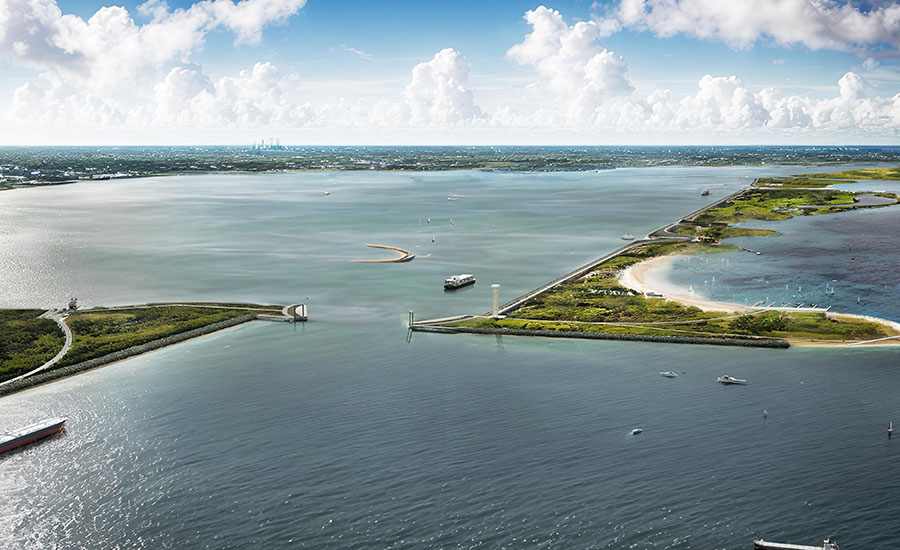
It’s not if, but when, a Category 5 hurricane slams into Texas’ Galveston Bay causing billions in destruction, possibly halting 14% of US crude oil refining and affecting five million people, say the experts at Walter P Moore and Associates and Rice University.
The engineer and the school, both Houston, are involved in the Galveston Bay Park Plan. The plan calls for the construction of a 22-mile chain of islands, at a cost of $6 billion, that would serve as a storm barrier to protect the Houston Ship Channel and the west side of Galveston Bay.
The barrier would also provide everyday benefits that would improve bay area habitat, improve water quality and provide much needed and rare public accessibility for bay recreation, says Charlie Penland, managing director of ‘Water P Moore infrastructures. The company is working with the university’s Center for Severe Storm Disaster Prediction, Education and Evacuation.
The proposal, presented in 2015, calls for a gate structure similar to that of the Maeslant barrier in Rotterdam, Holland, which will cross the canal, Penland says. In addition, there would be five more gates along the barrier where the existing canals will allow the passage of pleasure craft and drainage.
The project is part of a master plan for Galveston Bay that includes the coastal spine barrier that the US Army Corps of Engineers is now pushing through the environmental impact study phase to create the seaward barrier along Galveston Island and the Bolivar Peninsula, Walter P Moore said in an email.
“Compatible with [that]Galveston Bay Park Plan will replace planned improvements on the west side of the bay, saving [it] an estimated $2 billion and eliminating the impact on private and commercial properties that are part of the [Corps] plan,” the statement said.
The proposal work has been funded by several entities, including Houston, Harris County and the Port of Houston. In February, those responsible for the plan met with officials from the General Land Office, which is responsible for public land use, and are preparing to apply for an environmental permit next year.
Sea levels
According to the National Oceanic and Atmospheric Administration’s Sea Level Rise 2022 Technical Report, sea levels are projected to rise 10 to 12 inches by 2050, creating a massive change in coastal flooding over the next 25 years. Another study from Tulane University estimates that sea levels along the southeastern and Gulf coasts of the United States have risen at “record rates” over the past twelve years, about 0.05 inches per year since 2010. Sea level rise.org Predictions also show that sea levels will rise between 12 and 27 inches from 2016 to 2050.
The next Category 5 storm in the area could financially impact the global economy, Penland says.
Ten refineries are located in the Houston area, refining about 14% of US crude oil production or 2.6 million barrels per day. The top three oil producers refine more than 1.6 million barrels per day. “Anything that touches these complexes would be devastating from a national security standpoint,” Penland adds. “The whole financial world would be adversely affected.”
While still preparing for environmental studies, Penland says the Galveston Bay Park Plan would allow more room for development than the body’s plan to combat rising water levels.
“Because it comes from [university]it’s not tied to specific study guidelines that the Corps of Engineers has to follow … giving us a little more leniency in what we can consider,” says Penland. “So we’re seeing much more intense storms what [the Corps]. We are trying to identify ourselves [areas] that are beneficial that the Body cannot necessarily use in its calculations.”
The Corps has “very tight” guidelines on what it can build, including its cost-benefit analysis and government flood statistics, Penland adds.
The project is currently being evaluated to determine if it should be part of the Texas Coastal Surge Protection Plan or otherwise locally funded.
The goal is for the process to begin in 2030 at the latest.

